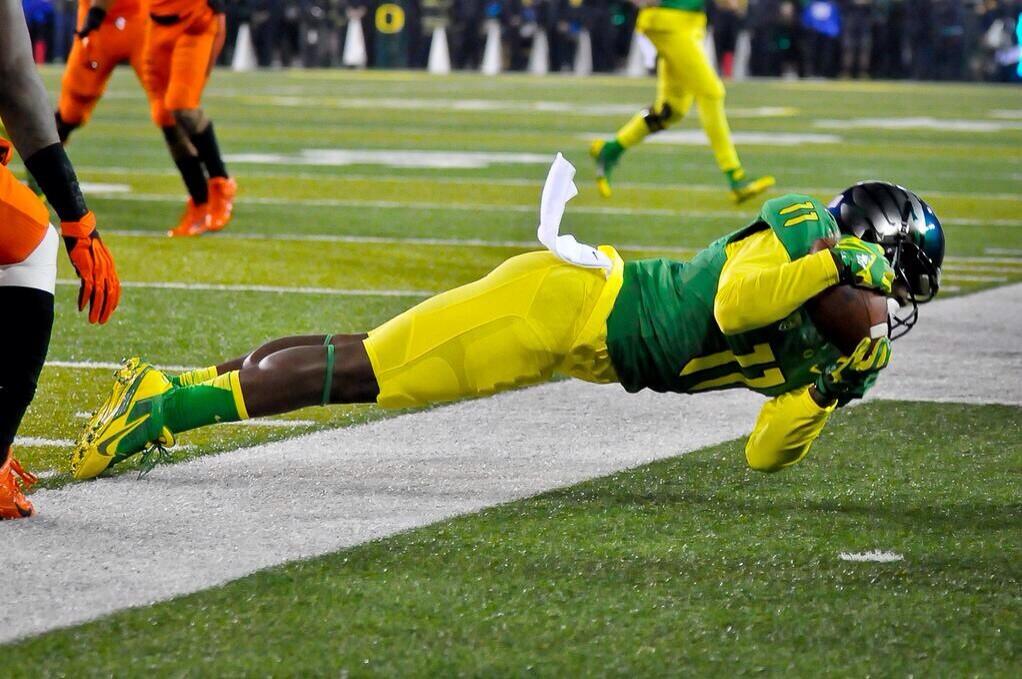
Psychologically, it’s probably part of the reason we’re so hard on Mark Helfrich and the Oregon Ducks. Watching football is our chance to expect excellence. We live through the kids, mentally rewriting the record of our own glory days, the passes we dropped, the trophies claimed, the kisses stolen and missed.
Supreme effort, impossible standards: how many times do we achieve this kind of excellence, where we work, relate and dream? (Zach Lee, Twitter.com photo). A lot of the comments and criticism of the Ducks these last few weeks should have been ruled out of bounds.
A fan on Rob Moseley’s Twitter quoted something Mark Helfrich said after the team banquet, “There are only two ways to be happy, and that’s to get better or lower our expectations. And we are never going to lower our expectations.”
Expectations at Oregon have grown to a point where many fans think anything less than 12 wins and a BCS bowl is failure. When the season began, many felt this was the deepest and most talented Oregon team ever, the best chance in a great run of recent success to win a national championship.
Still others remember a relatively short time ago when a winning season was a big accomplishment, and any bowl was a cause for jubilation. After a $68 million dollar locker room, lounge, study center and dining hall, a billboard in Times Square and four straight BCS bowls, fans still love the Ducks, but some love them way more when they win every game by 30.
I wrote two preseason stories about the outlook, one at the start of camp where I predicted Mark Helfrich’s first year would cause the Ducks to slip back a little, that they’d fall at Stanford and falter in one other game, probably at Washington, where the Huskies had a senior quarterback, a great downhill running back and an improved offensive line and defense. 10-2 seemed likely.
A couple of weeks into fall camp I reconsidered, buoyed by reports of great practices and progress. Byron Marshall and De’Anthony Thomas could handle the load at running back, spelled by promising freshman Thomas Tyner. The linebackers were coming along. It was the deepest defensive line in memory, a loaded secondary, and three potential all-league candidates on the offensive line in Hroniss Grasu, Tyler Johnstone, and Jake Fisher.
This was the year Oregon would go undefeated and win a national championship, I wrote. It was a ridiculous level of unqualified optimism, but when they handled an ACC road game and big SEC offensive and defensive lines, dispatched the Huskies on the road in convincing fashion and roadgraded UCLA to reach #2, 8-0 and the cover of Sports Illustrated, I felt vindicated and incredibly astute.
Then came November and a four-game stretch of the worst kind of tentative, disorganized, unfocused football in recent memory. Their gifted dual-threat quarterback twisted a knee and had to play hurt. The Ducks looked like a different team, undisciplined and poorly coached, unable to stop the run, get off the field on third down, block and tackle consistently, or hold on to the football. A couple of team leaders made unfortunate and overanalyzed comments on social media and to the press. They were embarrassed and physically manhandled by Stanford and Arizona, squeaked by Utah and Oregon State on breaks and an advantage in talent and speed.
The first prediction was closer to correct. I’ll have to be more cautious and measured next season, especially if Marcus Mariota, De’Anthony Thomas and Ifo Ekpre-Olomu leave for the NFL.
This afternoon I went to a small college playoff game today at Linfield, 4-time National Champions in NCAA Division II and Division III. The Wildcats trailed visiting Hamden-Sydney of Virginia 21-10 at halftime, giving up 304 yards passing in the first two quarters to a tall, gun-slinging quarterback, Nash Nance, a transfer from Tennessee with a quick release and a couple of fast, rangy outside receivers.
The Linfield coaches made great adjustments in the locker room, and their players played a determined game in the second half, scoring three touchdowns and getting more pressure on Nance. They won 31-21, advancing to the quarterfinals next week against #5 Wisconsin Whitewater.
Thomas Tyner was there, watching with a cluster of friends outside the ropes at the ten yard line. In a stocking cap, his Oregon letterman’s jacket and black skinny jeans, he looked unremarkable, just another college kid, except for the heads that turned and the necks that craned when he walked by the grandstands.
Most of us can barely fathom the attention and scrutiny those kids live with every day of their lives. Sure, they’re pampered and celebrated, working, studying and practicing in a football Taj Mahal. But hanging out with some buddies on the sideline at a small college football game in McMinnville, every pair of eyes in the stadium turned to see if Tyner was winning the day.
His team beat Oregon State Friday night with an incredible effort, displaying heart and poise to win a classic, spurred by legendary performances by Josh Huff, Ekpre-Olomu and Taylor Hart. The freshman from Aloha ran for 140 yards and a touchdown.
Fans aren’t likely to stop expecting more, from him or his teammates. It’s the price of fame, and sometimes, we can be cruel about it, forgetting that most of us went 8-4 this year. I cheated and made two predictions, and finished 1-1.
Add The Sports Daily to your Google News Feed!